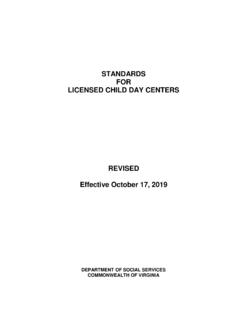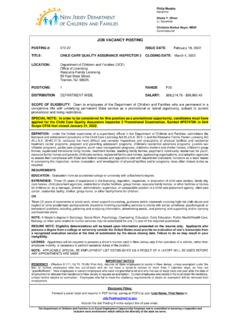Transcription of THE Child Care LICENSING Policy HANDBOOK
1 0 2021 UPDATED APRIL 2021 STATE OF SOUTH DAKOTA | THE Child CARE LICENSING Policy HANDBOOK Updated April 2021 1 Table of Contents SECTION 1 I ntroduction To LICENSING .. 2 SECTION 2 The L icensing Regulations .. 13 SECTION 3 S ample Forms .. 43 SECTION 4 Resources .. 69 SECTION 5 Emergency Preparedness .. 111 SECTION 6 Administrative Rules and Codified L aws .. 138 2 THE LICENSING Policy HANDBOOK SECTION 1 INTRODUCTION TO LICENSING Page Introduction .. 3 Categories of Licensed Child Care .. 4 Child Care Services LICENSING Offices .. 5 The LICENSING Process .. 6 Step 1: The Floor Plan Review .. 6 Step 2: The Application .. 8 Step 3: The Program Inspection .. 8 Step 4: The Facility Safety Inspection.
2 9 Step 5: Issuing the License .. 10 Step 6: Maintaining the License .. 10 Flow Chart of LICENSING Process .. 12 3 South Dakota has often been cited as having the highest percent in the nation of children under age six with all available parents in the labor force. South Dakota s working parents are a key element to the growth and wellbeing of the state. Another key element to the stability of South Dakota s workforce is the presence of early childhood professionals. As parents work each day outside their homes, quality care is needed to nurture and protect their children while they are away. LICENSING is a means of reducing the risk of harm to children in licensed programs by establishing and enforcing regulations that require maintenance of minimum standards of care. The LICENSING regulations consist of South Dakota Codified Laws (SDCL) and Administrative Rules of South Dakota (ARSD). The ARSD Chapters are given to each program at initial licensure and a new copy is provided to the program each year.
3 The ARSD Chapters pertinent for each type of licensed program can be found in Section 2 of this HANDBOOK . They can also be found online in their entirety at under each type of licensed program listed. A list of SDCL pertinent to licensed care can be found in Section 2 of this HANDBOOK or online at LICENSING is a form of consumer protection that decreases a Child s exposure to risk of fire, unsafe buildings, disease, injury, unsafe play equipment, etc. The LICENSING regulations can be seen as daily working tools that help Child care providers to remain alert to hazards and be safety conscious. Because the LICENSING regulations are the minimal requirements to be met, they do not guarantee a quality program. Progressive Child care programs are not typically satisfied with meeting only the minimal regulations, therefore they are constantly striving to go above the minimums for the children entrusted to their care. 4 Categories of Licensed Child Care Group Family Day Care (GFDC) Day Care Center (DCC) Before and After School Care (B&A) South Dakota law 26-6-14 defines a Group Family Child Care home as: Care provided for 13-20 children A service located in the providers own home or in a separate facility Care provided for part of a 24- hour period as a supplement to regular parental care If the Child care is located in a family home, the maximum number of children does include the provider s own children who are under six years of age South Dakota law 26-6-14 defines a Child Care Center as.
4 Care provided for 21 or more children A service most often located in a separate facility but can be located in the provider s home Care provided for part of a 24-hour time period as a supplement to regular parental care If the Child care is located in a family home, the maximum number of children does include the provider s own children who are under six years of age South Dakota law 26-6-14 defines a Before and After School Care program as: Care provided on a regular basis before and/or after regular school hours Care provided in a school or in a separate facility Care provided for part of a 24-hour period as a supplement to regular parental care Children of staff who work in the program count in the maximum number of children allowed Additional Factors Regarding GFDC Additional Factors Regarding DCC Additional Factors Regarding B&A School. Have a qualified staff person that plans and oversees the implementing of the daily activities All staff receive orientation training within 90 days of hire All staff receive 10 hours of training annually Establish written policies Inspections are conducted at least once per year May be eligible to receive reimbursement through the Child and Adult Care Food Program The cook can serve in ratio during food preparation.
5 Have a qualified staff person that plans and oversees the implementing of the daily activities All staff receive orientation training within 90 days of hire All staff receive 20 hours of training annually Establish written policies Inspections are conducted at least once per year May be eligible to receive reimbursement through the Child and Adult Care Food Program Care is provided to school age children only. If preschool children are in care, the program must meet DCC requirements Have a qualified staff person that plans and oversees implementation of the daily activities All staff receive orientation training within 90 days of hire All staff receive 10 hours of training each year Establish written policies Inspections are conducted at least once per year Additional Factors Regarding All Facility Types Based on state law, all of the above facility types must be licensed regardless of their funding source or whether or not there is compensation received for the services; LICENSING requirements are met and a license issued before the care of children begins.
6 Commercial Liability Insurance coverage is obtained Child to staff ratios are met at all times 5 Child Care Services (CCS) LICENSING Offices The CCS LICENSING offices listed below will provide key LICENSING support and assistance to new and existing Child care programs and before and after school programs. To obtain copies of LICENSING rules and materials and/or to receive assistance with LICENSING issues, contact your local CCS office. Aberdeen ..626-3160 or 1-866-239-8855 3401 10th Avenue SE, Aberdeen, 57 40 1-8000 Brookings* ..688-4330 or 1-866-267-5228 1310 S. Main Ave, Suite 101, Brookings, 57006 Pierre** .. 773 -352 9 or 1-800-227-3020 91 0 E. Sioux Avenue, Pierre, 57501 Rapid City ..394 -2525 or 1-800-644-2914 510 N. Cambell, PO Box 2440, Rapid City, 57709-2440 Sioux Falls.
7 367-5444 or 1-866-801-5421 811 East 10th St. Dept. 6, Sioux Falls, 57103-1650 ..995-8000 or 1-800-231-8346 116 E. 11th Avenue, Mitchell, 57301 *CCS LICENSING Supervisor is located in the Brookings Office **CCS Assistant Division Director, who provides Policy and procedure technical assistance to CCS LICENSING , is located in Pierre See the Child Care Services website at for more information on LICENSING coverage areas. 6 The LICENSING Process The following pages provide an overview of the LICENSING process from the initial inquiry to the issuance of the license, for each of the three types of licensed facilities: Group Family Day Care Home, Day Care Center and Before and After School Programs. Reminder: A program caring for 13 or more children is required to have a license before operating. The LICENSING specialist should be one of the main contacts during the start-up of a program.
8 There are several steps to the LICENSING process and the LICENSING specialist can provide assistance through each step. The steps involved in LICENSING are outlined in the following pages. STEP 1: THE FLOOR PLAN REVIEW One of the first steps in the LICENSING process is the floor plan review of the building to be used for care. The materials contained in the initial inquiry packet include a Floor Plan Review Process and Program Proposal HANDBOOK . This HANDBOOK explains in detail the information needed for the floor plan review process. Why a Plan Review? The floor plan review is completed in order to verify that the building meets fire and life safety codes as well as building codes, and to determine the maximum capacity of the licensed program. The floor plan review process must be completed before a license is issued and before the program begins operation. Some South Dakota cities also have requirements for operating a program, contact the local city government office for information on their requirements.
9 Timely Review. Submitting floor plans as early as possible and ensuring the plans contain all information outlined in the Floor Plan Review Process and Program Proposal HANDBOOK will help ensure a review is completed as quickly as possible. 7 A plan that is missing information, as outlined in the Floor Plan Review Process and Program Proposal HANDBOOK , can delay the review process and therefore the LICENSING process. Child Care Services (CCS) depends on two other state agencies to complete these reviews. These agencies work diligently to respond quickly but their response time depends on the number of reviews they receive each week. Details. The floor plan drawing itself can only provide so much information. There are many details (specifications) that are not included in a plan drawing that reviewers need to know, such as the type of fire alarm installed or type of wall coverings. The more detail provided in the specifications, the better picture the reviewers have of the program.
10 Photos are beneficial but not required. Don t hesitate to call the LICENSING specialist with any questions prior to submitting the floor plan. This could save everyone time in the long run. Renovation of a currently approved facility must also be approved through a floor plan review before the renovation begins to ensure compliance with the requirements is maintained. A program may only use space that has been approved through a floor plan review. Rooms that have not been approved, may not be used until a review is completed. Once the floor plan review is completed, the program will receive a letter completed by the Fire Marshall s Office and a letter completed by the Department of Health indicating the results of the plan review. Any items listed on the review letters must be corrected before the onsite inspections can be scheduled. 8 STEP 2: THE APPLICATION After a program submits the floor plans to Child Care Services (CCS), indicating their intent to operate a facility, the application for license is sent to the program.














